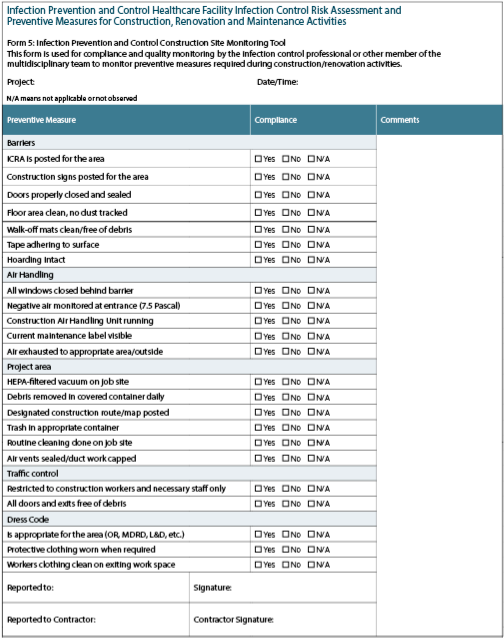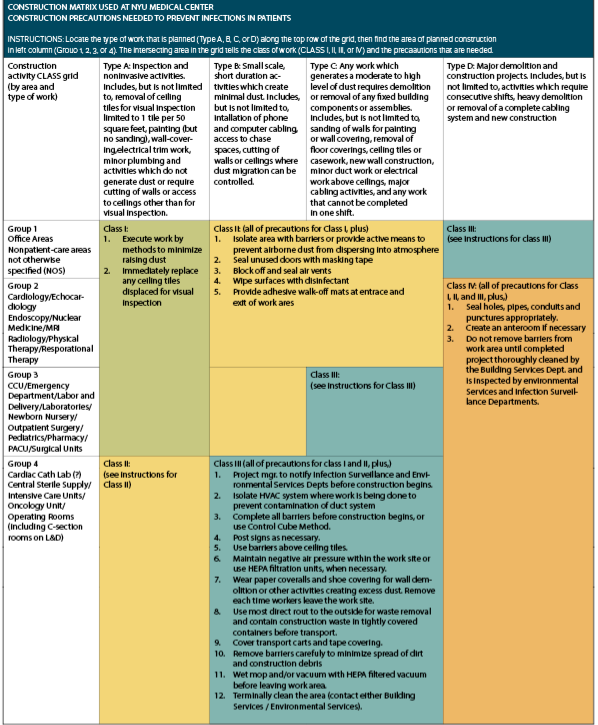From Blueprints to Ribbon Cutting: Infection Preventionists’ Role in Construction
When constructing a health care facility of any size, it is crucial to seek the advice and expertise of an infection preventionist. This article provides guidance on how to do so effectively.
(Left-click to open the table in a new window.)

Incorporating infection prevention and control measures throughout the entire construction process, from blueprint to ribbon cutting, can effectively reduce the incidence of infections from the outset. However, infection preventionists (IPs) are not often involved at the beginning of the construction process, or if they are, they are still determining what they should do. Here are the steps that IPs should follow to make sure infection prevention and control policies are implemented in the facility’s construction.
A typical infection prevention strategy involves the IP working with other stakeholders to establish work-related policies and procedures followed by frequent audits to confirm compliance with established policies and processes. The IP’s role is to ensure that the work is carried out to properly reduce the risk of potential infections and comply with the recommendations and policies dictated by local, state, and federal laws. It is not the IP’s responsibility to instruct a contractor on how to complete a task.1
Infection Control Risk Assessment (ICRA)6 is a process to assess the impact of construction and renovation work in health care facilities on infection control programs and practices and to ensure that new construction is designed to meet the needs of the anticipated patient population.1,2 IPs can actively participate in the design and oversight of health care construction and renovation projects by actively participating in the processes that assess and mitigate infection risks to patients, health care workers, and visitors. This article discusses infection control’s role in the construction and renovation of health care facilities.
Policy and Procedures
The IP should include a construction and renovation policy to promote a secure care environment for patients, visitors, health care professionals, and contractors. The policy should cover all aspects of building and remodeling projects that entail infection prevention and control. The policy should also state the need for the IP to be a part of the project team from the beginning of the project to the end.
This policy should include the following information:2 departmental responsibilities for each ICRA component, work types covered by the requirement, definitions of terms used in the ICRA, processes for confirming compliance with the ICRA, and any recordkeeping requirements associated with the ICRA process. Importantly, an IP should have authority outlined in the construction and renovation policy to halt the project immediately in case of unsafe practices.
(Left-click to open the table in a new window.)

The ICRA’s design section2,3 must at least tackle the following subjects: the quantity, location, and types of isolation rooms for airborne infection isolation and protective environments; a risk assessment for waterborne pathogens;5,6 the quantity, location, and types of handwashing stations and hand sanitation dispensers; any specific heating, air-conditioning, or other ventilation requirements; and mitigation measures and selections of materials for furniture and coatings. The IP should consider the regulatory requirements, local authorities, and international guidelines such as those of the Facility Guidelines Institute (FGI), CDC, and American Institute of Architects.
Infection Control Risk Mitigation Recommendations
Written infection control risk mitigation recommendation (ICRMR)2 plans created by the ICRA team are included in ICRA. At the very least, these written plans should cover the following topics: patient locations during construction and any need for patient relocation; containment barriers and other ICRMR construction phases and their impact on plumbing and ventilation systems; effect of the construction on traffic flow, access to exits, and operation of life safety systems; and any training needed for staff, construction workers, patients, or visitors. Information on the restroom and dining options should be accessible to construction employees. Installation of new materials must meet standards for cleanliness and the absence of water damage. IPs should know how the project will be monitored to verify the ICRMRs and what written processes will be used to halt work as necessary.7
Construction Risks
Construction activities in or near health care facilities can increase the risk of infection because of mold spores carried by air currents, waterborne pathogens in plumbing systems that have become stagnant because of a lack of use while construction is underway, or the disruption of accumulated biofilms on existing plumbing. In addition to the danger of infection, construction activity can irritate patients and other building occupants with noise, vibration, disruption of traffic flow, and odors. These construction-related effects are a further worry in patient care locations where residents cannot be moved during construction and when there are no unoccupied after-hours periods. Additionally, materials inside and outside the construction zone might be damaged by flooding brought on by building activity. Before working on or near plumbing fixtures, project managers should ensure construction employees know where the water shutdown valves are located. Before any flooding incident, having procedures for handling flooding can ensure a quick reaction that doesn’t increase the risk of infection. A flood checklist is listed by the CDC.5,6
Construction Containment
A barrier system may be put in place around construction work zones in health care institutions to keep any dust-produced and potentially contagious bacteria contained. These barriers include plasterboards, rigid plastic panels, or flame-resistant plastic sheets. In addition to the physical containment barrier, removing air from the enclosed construction area can result in lower air pressure than neighboring occupied spaces. Airflow from nearby clean spaces enters the enclosed workspace because of this reduced pressure, also known as negative pressure, before exiting the exhaust. The exhaust may be sent outside or, after passing through a high-efficiency particulate air (HEPA) filter, back into the building. Therefore, creating negative pressure within the contained work zone relative to adjacent spaces helps to prevent the release of airborne infectious agents in the event of a breach in the containment barrier or when opening doors to move workers and equipment in or out of the work zone.
Air Monitoring
Air sampling should be initiated with seriousness because the performance and interpretation of air cultures for fungi are relatively complex. However, the CDC does not recommend sampling for airborne microbial contaminants before, during, or after construction projects. There are several instances in which sampling may be judged necessary: when nosocomial infec¬tions are due to common environmental airborne fungi such as Aspergillus fumigatus, before initial occupancy of specially con¬trolled environments, and when procedures necessary for the cleanest air quality are being established and maintained.
Particle counts are recommended for monitoring the effectiveness of the construction containment. A significant increase in the airborne particle counts near the construction containment relative to the surrounding background levels may indicate a breach or leak. Particle counts are also used to check the functionality of HEPA filters in vacuums and negative air machines. There are no recognized safe or dangerous particle levels to use as a benchmark.1,2
Water System and Quality Monitoring
Because of mold growth following water damage, many issues for controlling construction aerosols have been shifted to source management. During renovation projects, the water quality management team may request routine flow of water lines not used regularly to ensure that chlorine or other disinfectants in the water remain at effective concentrations to control bacterial and biofilm growth. Additionally, with plumbing dead legs (the part of the pipe that is not in use), the water inside becomes stagnant and at risk for microbial amplification. The IP should discuss prevention and control measures such as removing plumbing dead legs encountered or created during the planned project. If the dead leg cannot be removed, a valve may be installed to isolate it from the flowing main line so the abandoned pipe may be left in place. It may be simpler to handle future shutdowns for maintenance, remodeling, or pathogen outbreak control if isolation valves, recirculating plumbing systems, and connections for injecting chlorine or other disinfectants are strategically placed. Also, the IP should consider measures to control the growth of Legionella and other waterborne pathogens in plumbing systems, procedures, and schedules used for flushing and disinfecting the system before occu¬pancy when construction is completed. Unless the institution has a history of issues with water bacteria, typically Legionella, testing is typically not consid¬ered. To ensure there has been no fecal contamination, new water systems must undergo coliform testing.2
Working With the Construction Team
The IP can think about mandating formal training or competency testing for the project managers and construction personnel implementing infection prevention suggestions. Health care facilities frequently require tuberculosis testing and immunizations for staff members, including external contractors who often operate in patient care areas. Additionally, programs can detect workers who are actively coughing or have exposed skin rashes and prohibit them from working in the regions that provide patient care.
After Construction and Before Occupancy
The ICRA and contract documents should specify how the containment barriers should be taken down and how the construction area should be cleaned up when the job is over. Before returning to the location to provide service, facility workers should conduct a routine clean¬ing of the area. The IPs should verify the ventilation system’s balance and perfor-mance levels to ensure they meet design requirements. Before putting any ducts back into service, clean any improperly sealed ones that became contaminated with building dust.1,2
Conclusions
The IP has a vital role in both the design and construction phases of health care facilities. The IP collaborates with the construction team and clinical personnel early in the design process to identify potential infection concerns and then specifies the materials and designs that will best reduce those risks. The IP should be familiar with the construction process and the expectations for infection prevention during construction using resources such as the guidelines from the FGI, CDC, and the Association for Professionals in Infection Control and Epidemiology.
References:
1. Johnson L. Construction and renovation. December 14, 2015. Revised May 27, 2019. Accessed June 20, 2023. https://text.apic.org/toc/infection-prevention-for-support-services-and-the-care-environment/construction-and-renovation
2. Booth RD, Kobus C, Stever R. ASHE ICRA 2.0 Process Guide. American Society for Health Care Engineering. Accessed June 20, 2023. https://www.ashe.org/icra-2-process-guide
3. Association for Professionals in Infection Control and Epidemiology. Infection Prevention Manual for Construction & Renovation. Association for Professionals in Infection Control and Epidemiology; 2019. Accessed June 20, 2023. https://apic.org/Resource_/store/books/preview/SLS9808_Preview.pdf
4. Facility Guidelines Institute. 2018. Accessed June 20, 2023. https://fgiguidelines.org
5. Checklist for infection control concerns when reopening healthcare facilities closed due to extensive water and wind damage. CDC. Accessed June 20, 2023. https://www.cdc.gov/disasters/reopen_healthfacilities_checklist.html
6. Recommendations for the cleaning and remediation of flood-contaminated HVAC systems: a guide for building owners and managers. CDC. Accessed June 20, 2023. https://www.cdc.gov/niosh/topics/emres/cleaning-flood-hvac.html
7. Journal of Perioperative Nursing Clinics 3(2008). Pgs 137-142.
8. Morris G, Kokki MH, Anderson K, Richardson MD. Sampling of Aspergillus spores in air. J Hosp Infect. 2000;44(2):81-92. doi:10.1053/jhin.1999.0688
Show, Tell, Teach: Elevating EVS Training Through Cognitive Science and Performance Coaching
April 25th 2025Training EVS workers for hygiene excellence demands more than manuals—it requires active engagement, motor skills coaching, and teach-back techniques to reduce HAIs and improve patient outcomes.
Phage Therapy’s Future: Tackling Antimicrobial Resistance With Precision Viruses
April 24th 2025Bacteriophage therapy presents a promising alternative to antibiotics, especially as antimicrobial resistance continues to increase. Dr. Ran Nir-Paz discusses its potential, challenges, and future applications in this technology.
Robust infectious disease surveillance, including rapid subtyping of influenza A, is essential for early detection, containment, and public health reporting of novel viral threats.
